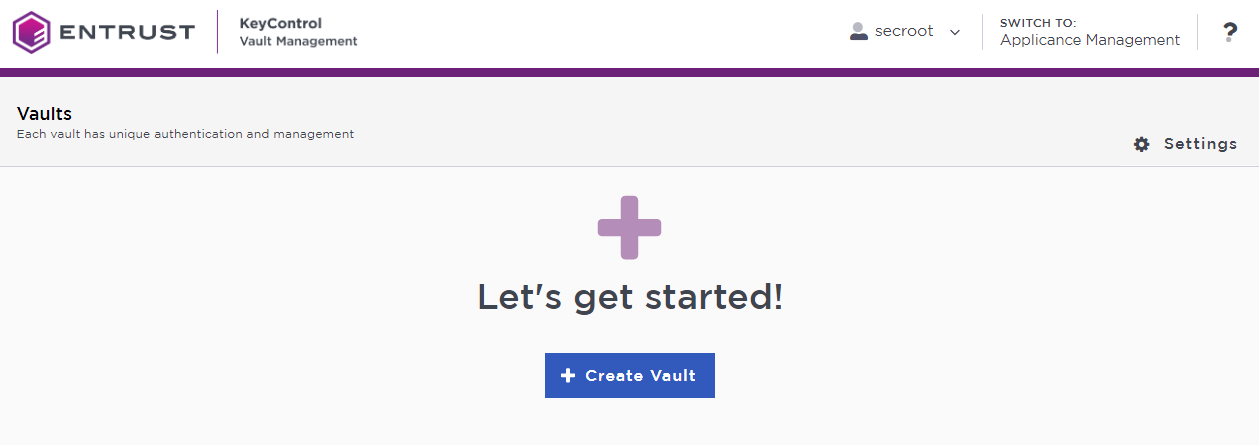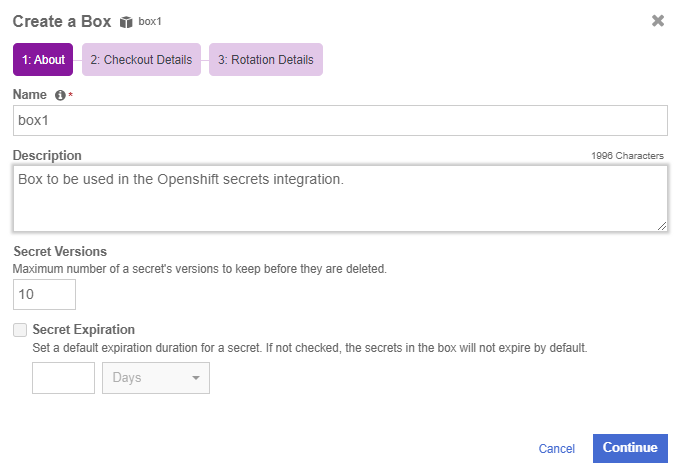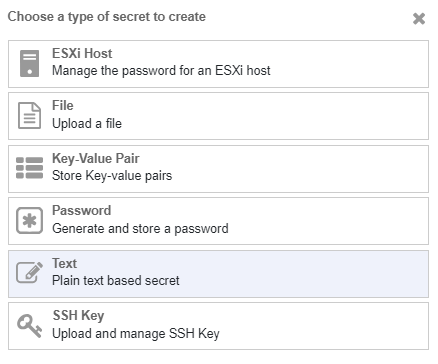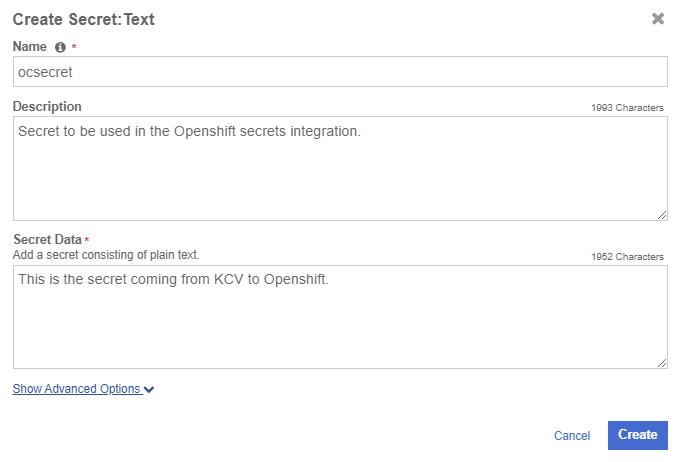Procedures
RedHat Linux Server
On a RedHat Linux server do the following:
-
Install docker:
% sudo dnf install docker
Deploy a KeyControl Vault cluster
For this integration, KeyControl Vault was deployed as a two-node cluster.
Follow the installation and setup instructions in KeyControl Vault Installation and Upgrade Guide.
Create a Secrets Vault to be used with Openshift
-
Sign in to the KeyControl Vault Manager.
-
In the home page, select Create Vault.

The Create Vault dialog appears.
-
In the Type drop-down box, select Secrets. Enter the required information.
-
Select Create Vault.
For example:

-
When you receive an email with a URL and sign-in credentials to the KeyControl vault, bookmark the URL and save the credentials.
You can also copy the sign-in credentials when the vault details gets displayed.
-
Sign in to the URL provided.
-
Change the initial password when prompted.
Create a secret in the Secrets Vault.
After you sign in to the secrets vault, create a box that will contain the secret.
-
Select Manage in the Secrets Vault Home tab, then select Manage Boxes.
-
In the Manage Boxes Tab, select Add a Box Now.
-
In the Create a Box Window, enter the Name and Description.
In this integration guide and the configuration file examples it contains, the box will be named box1.
-
Select Continue.

-
In Checkout Details, select Continue.
-
In Rotation Details, select Create. The box gets created.
-
Select the new box.
-
In the Secrets Pane, select Add a Secret Now.
-
From the Choose a type of secret to create list, select Text.

-
In the Create Secret: Text window, enter the following:
-
Name: Enter the name of the secret. This will be used later in configuration files in this integration.
-
Description: Enter a brief description.
-
Secret Data: Enter the value of the secret. This is the value the Openshift containers will try to retrieve during the integration.

-
-
Select Create.
Setup and Configuration
Configure the environment for the integration. From this point on, all setup and configuration will be done from the linux server that was set up earlier.
Setup KUBECONFIG
This should give you access to the Openshift cluster.
% export KUBECONFIG=<path-to-your-kubeconfig-file>Check that you can see the Openshift cluster nodes:
% oc get nodes
NAME STATUS ROLES AGE VERSION
ocp4147-r758r-master-0 Ready control-plane,master 3d1h v1.27.8+4fab27b
ocp4147-r758r-master-1 Ready control-plane,master 3d1h v1.27.8+4fab27b
ocp4147-r758r-master-2 Ready control-plane,master 3d1h v1.27.8+4fab27b
ocp4147-r758r-worker-0-ctl28 Ready worker 3d v1.27.8+4fab27b
ocp4147-r758r-worker-0-t7lfl Ready worker 3d v1.27.8+4fab27b
ocp4147-r758r-worker-0-vbwrb Ready worker 3d v1.27.8+4fab27bSet up namespaces
The integration will use two namespaces in Openshift.
-
Set up the mutating webhook namespace.
-
Create a yaml file containing the following code:
apiVersion: v1 kind: Namespace metadata: name: mutatingwebhook -
Name the file
mutatingwebhooknamespace.yaml -
Create the namespace:
% oc create -f mutatingwebhooknamespace.yaml
-
-
Set up the test namespace.
-
Create a yaml file containing the following code:
apiVersion: v1 kind: Namespace metadata: name: testnamespace -
Name the file
testnamespace.yaml. -
Create the namespace:
% oc create -f testnamespace.yaml
-
Docker registry
Register some of the docker container images to a docker registry so they can be used inside the Openshift Cluster.
-
Set up
DOCKER_CONFIGExport
DOCKER_CONFIGto the directory where your docker configuration will be stored:% export DOCKER_CONFIG=~/.docker -
Log in to the registry:
% docker login -u YOURUSERID <registry-url> -
Deploy the init container image.
The init container image needs to be deployed to the docker registry.
-
Download the init container image:
% wget https://github.com/EntrustCorporation/PASM-Vault-Kubernetes-Agent/releases/download/v1.0/init-container.tar -
Load the provided image
init-container.tarinto the docker registry:% docker load --input init-container.tar -
Check the image:
% docker images REPOSITORY TAG IMAGE ID CREATED SIZE localhost/init-container latest 1c476f57b72c 10 months ago 186 MB -
Tag the Image:
% docker tag localhost/init-container:latest <registry-url>/init-container -
Push the image into the docker registry that is used within Openshift:
% docker push <registry-url>/init-container:latest
-
-
Deploy the mutating webhook image.
The webhook code is in the form of image and needs to be deployed as container. It needs to be deployed to the docker registry.
-
Download the webhook container image:
% wget https://github.com/EntrustCorporation/PASM-Vault-Kubernetes-Agent/releases/download/v1.0/mutating-webhook.tar -
Load the provided image
mutating-webhook.tarinto the docker registry:% docker load --input mutating-webhook.tar -
Check the image:
% docker images REPOSITORY TAG IMAGE ID CREATED SIZE localhost/mutating-webhook latest 805efa734095 10 months ago 222 MB -
Tag the Image:
% docker tag localhost/mutating-webhook:latest <registry-url>/mutating-webhook -
Push the image into the docker registry that is used within Openshift:
% docker push <registry-url>/mutating-webhook:latest
-
Get the Secrets Vault Authentication token for the vault Admin User.
-
Log in to the Secrets vault as admin using the KeyControl Vault Rest API and get the vault authentication token.
https://<VAULT-IP>/vault/1.0/Login/<VAULT-UUID>This URL is visible on vault management UI of the KeyControl. Also note the
VAULT-UUIDfrom the URL. This will be required in further steps.Here is an example:
https://xx.xxx.xxx.xxx/vault/1.0/Login/7e6e8646-20f0-41a5-8bb6-a17dff64aff2The request body should be in the form:
{ "username":"admin", "password":"password" }The usernameshould be one of the administrators of the vault. The examples usesadmin, but this should be the actual admin user name. -
Get the token using the following curl command:
% curl -k -X POST https://xx.xxx.xxx.xxx/vault/1.0/Login/7e6e8646-20f0-41a5-8bb6-a17dff64aff2/ -d '{ "username": "admin", "password":"xxxxxxx" }'The response body for the command above should be similar to this:
{ "is_user": false, "box_admin": false, "appliance_id": "bc1a085c-70c9-476c-b4f6-abff0c73cce4", "is_secondary_approver": false, "access_token": "N2U2ZTg2NDYtMjBmMC00MWE1LThiYjYtYTE3ZGZmNjRhZmYy.eyJkYXRhIjoiU0ZSWFVBRUFldWJCSDNXamtrazRFWkI4ZFA4dzlRMFNtWnpuaEVFNGtnaFRLU1FOVWRMRWlxbVlVUy9aWHR0WUFYTUFwWU9SejZsS1Vhb3NnYitkcGh1N3lRQUFBQ1FBQUFCbWFycFdJbmpGU1NlQk1ZTjRVZTZHT2llcWVFVVNaRjhhai95bGQ5ZFlxY21xN2FmQ1JSRGgxYTlCSVNBYlREcTJ1dFdUWGI3QnZNODRvakYzZFdPZG54Ym1pUGpQRUJxblB5cTFuL2ZpYnpUdmx5SHVWb05aSnh6WXM0cjJXQTNvU1AzeDgwK0ZmMHR5cm4xZHBJSFRUNG4zWHhrL1JRSEdFZ3pSR2pkOUI0WVN0ZGRwV3hMV1gvSGIyMzBIUUhPYVNvWURzdnJQU3BSb1lyQVZWK2JkMDVkYXV0RzN4OERYRTlJS2VFd0VBbjZwcG9xN3hJSHZTdTJrdDdLaWpRb1p6Y3pORmNLTzJlSTFaVGszTVRaall5MHpaRGxpTFRRME9UQXRPV1ppWkMxa01UVXpOamd6WkdGaVltTT0iLCJzcGVjIjoxLCJpZCI6IjVlOTcxNmNjLTNkOWItNDQ5MC05ZmJkLWQxNTM2ODNkYWJiYyJ9", "expires_at": "2024-08-27T13:22:02.216046Z", "admin": true, "user": "admin" } -
Copy the token received in the response body in the field
access_token.This is required when executing APIs described in further steps and is referred to as Vault Authentication Token. The
access_tokenfield will be used in thecurlheaders from now on for the rest of the configuration calls. For example:curl -H "X-Vault-Auth: N2U2ZTg2NDYtMjBmMC00MWE1LThiYjYtYTE3ZGZmNjRhZmYy.eyJkYXRhIjoiU0ZSWFVBRUFldWJCSDNXamtrazRFWkI4ZFA4dzlRMFNtWnpuaEVFNGtnaFRLU1FOVWRMRWlxbVlVUy9aWHR0WUFYTUFwWU9SejZsS1Vhb3NnYitkcGh1N3lRQUFBQ1FBQUFCbWFycFdJbmpGU1NlQk1ZTjRVZTZHT2llcWVFVVNaRjhhai95bGQ5ZFlxY21xN2FmQ1JSRGgxYTlCSVNBYlREcTJ1dFdUWGI3QnZNODRvakYzZFdPZG54Ym1pUGpQRUJxblB5cTFuL2ZpYnpUdmx5SHVWb05aSnh6WXM0cjJXQTNvU1AzeDgwK0ZmMHR5cm4xZHBJSFRUNG4zWHhrL1JRSEdFZ3pSR2pkOUI0WVN0ZGRwV3hMV1gvSGIyMzBIUUhPYVNvWURzdnJQU3BSb1lyQVZWK2JkMDVkYXV0RzN4OERYRTlJS2VFd0VBbjZwcG9xN3hJSHZTdTJrdDdLaWpRb1p6Y3pORmNLTzJlSTFaVGszTVRaall5MHpaRGxpTFRRME9UQXRPV1ppWkMxa01UVXpOamd6WkdGaVltTT0iLCJzcGVjIjoxLCJpZCI6IjVlOTcxNmNjLTNkOWItNDQ5MC05ZmJkLWQxNTM2ODNkYWJiYyJ9" ...
Configure Openshift cluster with KeyControl Secrets vault.
To configure an Openshift cluster in the Keycontrol vault, the following API needs to be executed.
https://<VAULT-IP>/vault/1.0/SetK8sConfigurationThe headers must have the vault authentication token, X-Vault-Auth*: <VAULT-AUTHENTICATION-TOKEN>.
The request body should be in the form:
{
// URL of Openshift API server (or Loadbalancer if one is setup in front of
// control plane) along with port. This URL must be accessible by PASM vault.
// If Cluster is behind a service mesh, a proper ingress should be configured
// so that API server is accessible.
"k8s_url": "https://<KC-ACCESSIBLE-IP>/<FQDN of K8s API server>:6443",
// Base64 encoded string of the certificate presented by API server during SSL handshake
"k8s_ca_string": "<BASE64-ENCODED-CA-STRING>",
// Indicates whether this configuration should be enabled or not. Valid values
// are 'enabled' or 'disabled'. If the value is 'disabled', then "k8s_url" and
// "k8s_ca_string" won't be validated and won't be saved in the configuration.
"k8s_status": "enabled",
}The certificate string can be obtained from the kubeconfig file or by using following command:
% oc config view --raw -o jsonpath='{.clusters[0].cluster.certificate-authority-data}'
If Openshift is configured with multiple clusters, replace the number 0 by the appropriate cluster number.
The certificate string retrieved is already base64 encoded.
You do not need to encode it again.
|
The final request body:
{
"k8s_url": "https://api.ocp4147.interop.local:6443",
"k8s_ca_string": "<certificate-string>",
"k8s_status": "enabled"
}Save the request body in a file named SetK8sConfiguration.body and execute the following command:
% curl -H "X-Vault-Auth: N2U2ZTg2NDYtMjBmMC00MWE1LThiYjYtYTE3ZGZmNjRhZmYy.eyJkYXRhIjoiU0ZSWFVBRUFldWJCSDNXamtrazRFWkI4ZFA4dzlRMFNtWnpuaEVFNGtnaFRLU1FOVWRMRWlxbVlVUy9aWHR0WUFYTUFwWU9SejZsS1Vhb3NnYitkcGh1N3lRQUFBQ1FBQUFCbWFycFdJbmpGU1NlQk1ZTjRVZTZHT2llcWVFVVNaRjhhai95bGQ5ZFlxY21xN2FmQ1JSRGgxYTlCSVNBYlREcTJ1dFdUWGI3QnZNODRvakYzZFdPZG54Ym1pUGpQRUJxblB5cTFuL2ZpYnpUdmx5SHVWb05aSnh6WXM0cjJXQTNvU1AzeDgwK0ZmMHR5cm4xZHBJSFRUNG4zWHhrL1JRSEdFZ3pSR2pkOUI0WVN0ZGRwV3hMV1gvSGIyMzBIUUhPYVNvWURzdnJQU3BSb1lyQVZWK2JkMDVkYXV0RzN4OERYRTlJS2VFd0VBbjZwcG9xN3hJSHZTdTJrdDdLaWpRb1p6Y3pORmNLTzJlSTFaVGszTVRaall5MHpaRGxpTFRRME9UQXRPV1ppWkMxa01UVXpOamd6WkdGaVltTT0iLCJzcGVjIjoxLCJpZCI6IjVlOTcxNmNjLTNkOWItNDQ5MC05ZmJkLWQxNTM2ODNkYWJiYyJ9" -k -X POST https://xx.xxx.xxx.xxx/vault/1.0/SetK8sConfiguration/ --data @./SetK8sConfiguration.bodyThe response should be:
{
"Status": "Success",
"Message": "Kubernetes configuration updated successfully"
}Set the namespace.
Before proceeding with the rest of the configuration, set the namespace in openshift to the mutatingwebhook namespace created earlier.
% oc config set-context --current --namespace=mutatingwebhookCreate the registry secrets inside the namespace
The credentials for the external docker registry access need to be created so they can be mentioned in the pod deployment specification.
-
Create the secret in the namespace:
% oc create secret generic regcred --from-file=.dockerconfigjson=$HOME/.docker/config.json --type=kubernetes.io/dockerconfigjson -
Confirm that the secret was created:
% oc get secret regcred
Deploy the webhook container.
Use the following yaml specification to deploy the webhook container in Openshift:
apiVersion: apps/v1
kind: Deployment
metadata:
name: mutatingwebhook
namespace: mutatingwebhook
labels:
app: mutatingwebhook
spec:
replicas: 1
selector:
matchLabels:
app: mutatingwebhook
template:
metadata:
labels:
app: mutatingwebhook
spec:
containers:
- name: mutatingwebhook
image: 1.2.3.4:5000/mutating-webhook:latest
ports:
- containerPort: 5000
env:
# Specify these variables either as a mutatingwebhook container environment variables or
# add appropriate annotations in the pod specification. Refer documentation further to get
# the details about annotations. The annotations in pod specifications, if specified, take
# precedance over these environment variables.
- name: ENTRUST_VAULT_IPS
value: <comma-separated-list-of-vault-ips>
- name: ENTRUST_VAULT_UUID
value: <uuid-of-vault-from-which-secrets-to-be-fetched>
- name: ENTRUST_VAULT_INIT_CONTAINER_URL
value: <complete-url-of-init-container-image-from-image-registry>
securityContext: #Required, only if deploying on OpenShift
allowPrivilegeEscalation: false #Required, only if deploying on OpenShift
capabilities: #Required, only if deploying on OpenShift
drop: #Required, only if deploying on OpenShift
- ALL #Required, only if deploying on OpenShift
securityContext: #Required, only if deploying on OpenShift
runAsNonRoot: true #Required, only if deploying on OpenShift
runAsUser: 1000700000 #Required, only if deploying on OpenShift
seccompProfile: #Required, only if deploying on OpenShift
type: RuntimeDefault #Required, only if deploying on OpenShift
If image registry requires authentication, then make sure to add the credentials as secret in the yaml specification by adding the imagePullSecrets tag in the containers section.
|
Save the yaml in a file called mutatingwebhook.yaml.
apiVersion: apps/v1
kind: Deployment
metadata:
name: mutatingwebhook
namespace: mutatingwebhook
labels:
app: mutatingwebhook
spec:
replicas: 1
selector:
matchLabels:
app: mutatingwebhook
template:
metadata:
labels:
app: mutatingwebhook
spec:
imagePullSecrets:
- name: regcred # external registry secret created earlier
containers:
- name: mutatingwebhook
image: >-
<registry-url>/mutating-webhook
ports:
- containerPort: 5000
env:
# Specify these variables either as a mutatingwebhook container environment variables or
# add appropriate annotations in the pod specification. Refer documentation further to get
# the details about annotations. The annotations in pod specifications, if specified, take
# precedance over these environment variables.
- name: ENTRUST_VAULT_IPS
value: 1x.19x.14x.20x,1x.19x.14x.21x
- name: ENTRUST_VAULT_UUID
value: 7e6e8646-20f0-41a5-8bb6-a17dff64aff2
- name: ENTRUST_VAULT_INIT_CONTAINER_URL
value: <registry-url>/init-container
securityContext: #Required, only if deploying on OpenShift
allowPrivilegeEscalation: false #Required, only if deploying on OpenShift
capabilities: #Required, only if deploying on OpenShift
drop: #Required, only if deploying on OpenShift
- ALL #Required, only if deploying on OpenShift
securityContext: #Required, only if deploying on OpenShift
runAsNonRoot: true #Required, only if deploying on OpenShift
runAsUser: 1000700000 #Required, only if deploying on OpenShift
seccompProfile: #Required, only if deploying on OpenShift
type: RuntimeDefault #Required, only if deploying on OpenShiftPay attention to these sections and adjust according to your environment.
imagePullSecrets:
- name: regcred # external registry secret created earlier
image: >-
<registry-url>/mutating-webhook
- name: ENTRUST_VAULT_IPS
value: 1x.19x.14x.20x,1x.19x.14x.21x
- name: ENTRUST_VAULT_UUID
value: 7e6e8646-20f0-41a5-8bb6-a17dff64aff2
- name: ENTRUST_VAULT_INIT_CONTAINER_URL
value: <registry-url>/init-containerDeploy the file:
% oc create -f mutatingwebhook.yamlCheck if the multating webhook deployment is running:
$ oc get pods
NAME READY STATUS RESTARTS AGE
mutatingwebhook-c7958b7f9-dwd9x 1/1 Running 0 5s
$ oc describe pod mutatingwebhook-c7958b7f9-dwd9x
Name: mutatingwebhook-c7958b7f9-dwd9x
Namespace: mutatingwebhook
Priority: 0
Service Account: default
Node: ocp4147-r758r-worker-0-t7lfl/1x.19x.14x.2xx
Start Time: Tue, 27 Aug 2024 13:20:12 -0400
Labels: app=mutatingwebhook
pod-template-hash=c7958b7f9
Annotations: k8s.ovn.org/pod-networks:
{"default":{"ip_addresses":["10.129.2.136/23"],"mac_address":"0a:58:0a:81:02:88","gateway_ips":["10.129.2.1"],"routes":[{"dest":"10.128.0....
k8s.v1.cni.cncf.io/network-status:
[{
"name": "ovn-kubernetes",
"interface": "eth0",
"ips": [
"10.129.2.136"
],
"mac": "0a:58:0a:81:02:88",
"default": true,
"dns": {}
}]
openshift.io/scc: restricted-v2
seccomp.security.alpha.kubernetes.io/pod: runtime/default
Status: Running
SeccompProfile: RuntimeDefault
IP: 10.129.2.136
IPs:
IP: 10.129.2.136
Controlled By: ReplicaSet/mutatingwebhook-c7958b7f9
Containers:
mutatingwebhook:
Container ID: cri-o://a05bed83d3c0d5ac39a1d421e9dc992cdbf6cb3550826520dd978eb3da927a02
Image: <registry-url>/mutating-webhook
Image ID: <registry-url>/mutating-webhook@sha256:d5379f9b116f725c1e34cda7f10cba2ef7ed369681a768fb985d098cd24f1b1d
Port: 5000/TCP
Host Port: 0/TCP
State: Running
Started: Tue, 27 Aug 2024 13:20:14 -0400
Ready: True
Restart Count: 0
Environment:
ENTRUST_VAULT_IPS: 1x.19x.14x.20x,1x.19x.14x.21x
ENTRUST_VAULT_UUID: 7e6e8646-20f0-41a5-8bb6-a17dff64aff2
ENTRUST_VAULT_INIT_CONTAINER_URL: <registry-url>/init-container
Mounts:
/var/run/secrets/kubernetes.io/serviceaccount from kube-api-access-qpv28 (ro)
Conditions:
Type Status
Initialized True
Ready True
ContainersReady True
PodScheduled True
Volumes:
kube-api-access-qpv28:
Type: Projected (a volume that contains injected data from multiple sources)
TokenExpirationSeconds: 3607
ConfigMapName: kube-root-ca.crt
ConfigMapOptional: <nil>
DownwardAPI: true
ConfigMapName: openshift-service-ca.crt
ConfigMapOptional: <nil>
QoS Class: BestEffort
Node-Selectors: <none>
Tolerations: node.kubernetes.io/not-ready:NoExecute op=Exists for 300s
node.kubernetes.io/unreachable:NoExecute op=Exists for 300s
Events:
Type Reason Age From Message
---- ------ ---- ---- -------
Normal Scheduled 17s default-scheduler Successfully assigned mutatingwebhook/mutatingwebhook-c7958b7f9-dwd9x to ocp4147-r758r-worker-0-t7lfl
Normal AddedInterface 17s multus Add eth0 [10.129.2.136/23] from ovn-kubernetes
Normal Pulling 17s kubelet Pulling image "registry.eselab.net/mutating-webhook"
Normal Pulled 16s kubelet Successfully pulled image "<registry-url>/mutating-webhook" in 1.14339284s (1.143433867s including waiting)
Normal Created 16s kubelet Created container mutatingwebhook
Normal Started 16s kubelet Started container mutatingwebhookDeploy the entrust-pasm service.
-
Create a
yamlfile namedentrustpasmservice.yamlthat contains the following code:apiVersion: v1 kind: Service metadata: name: entrust-pasm # DO NOT CHANGE THIS namespace: mutatingwebhook # DO NOT CHANGE THIS spec: selector: app: mutatingwebhook ports: - protocol: TCP port: 5000 targetPort: 5000 -
Run the following command to create the service:
% oc create -f entustpasmservice.yaml -
Check the service:
% oc get service NAME TYPE CLUSTER-IP EXTERNAL-IP PORT(S) AGE entrust-pasm ClusterIP 172.30.233.96 <none> 5000/TCP 8s
Obtain the webhook server certificate.
After the container is deployed, obtain the webhook server certificate. This certificate will be needed to configure the webhook in openshift. Use the following command:
% oc exec -it -n mutatingwebhook $(kubectl get pods --no-headers -o custom-columns=":metadata.name" -n mutatingwebhook) -- wget -q -O- localhost:8080/ca.pemThe output should be something like this:
LS0tLS1CRUdJTiBDRVJUSUZJQ0FURS0tLS0tCk1JSUZTekNDQXpPZ0F3SUJBZ0lVRUFiWFlYazZHVUVJM2lrUGZQbnp4MVRMRjdVd0RRWUpLb1pJaHZjTkFRRUwKQlFBd1FERXhNQzhHQTFVRUF3d29TSGxVY25WemRDQkxaWGxEYjI1MGNtOXNJRU5sY25ScFptbGpZWFJsSUVGMQpkR2h2Y21sMGVURUxNQWtHQTFVRUJoTUNWVk13SGhjTk1qUXdPREkzTVRjeU1ERTNXaGNOTXpRd09ESTFNVGN5Ck1ERTNXakJBTVRFd0x3WURWUVFERENoSWVWUnlkWE4wSUV0bGVVTnZiblJ5YjJ3Z1EyVnlkR2xtYVdOaGRHVWcKUVhWMGFHOXlhWFI1TVFzd0NRWURWUVFHRXdKVlV6Q0NBaUl3RFFZSktvWklodmNOQVFFQkJRQURnZ0lQQURDQwpBZ29DZ2dJQkFMTlVMQk5KVVVzYU1nSHlrR3hHOWcvdFBtZXdFTi9DODVlSFJjMmREOHZyZndiNkZ5dFg3UG1BCnRhSVliMmJ4OUdTaldXVFlNNXlPL0g5WkY5L3BjUmJuYkdaNFBMTzBGdG1vM2FicCszRVJjTENWREZCamszQlcKTW9hOWQ1VVBkU2kzYnFBdGFrT2xFZHdOQ2ZvSWhlMDZNOGF2TDcrVWtZV1FQWGppMzBDODZCUTRRWE01dkFKQwpwaFg1NmhCY3N1RjJDc0w2cGZYUjlJbFVjVTgwZFBKN1BiT3ZubWdNbGpYakpYUnpHREJOUG9VS25HNmJ5N0tpCjV2TkNBaXYxRmJPQUxXUlZCZWdRUHZEdmpJRmVoMzBZUDRkamlydk5Yc1pNZnRiamFzZFVPWGhIMGFYK1BYN3cKYTNFRUpZL290TjR4VVlLaTFGRlhteDRRWTZaSTVheWdnTzNHSTZEWDJUcENQUzFqcnpXL2xETzhtd1QzNEhFSApKSno1T05abkRGME40YXJJWnFKa2dUVTd2Q1RaL3ltaWFsc2lDNkJQM1lUTkl5NmlKY1loczFUYWRQUVpmaElnCmxqeFhPQ2dDTXdLV1poNjdPdEtWTkNmeC83ZzBsbHhyeW1YY0xoY25aRy81azRDbmlmZHVTQWl4a1hRRVpXaTcKenRJL0ZIZjJMVGNrVkNnSms5NDlJSlNpSTdVREQwQkFHTkVnTE5hVnFBQ0pRbTNlQmVTS24xZ0c0ODNHMTRQawp5MkYyMEpEelBreG5ZVlBoVkVpK29scXZ3ZFVPVlFNWFV5UTUyQTZ5RTQwZFZsSjBIZGJoTjdzOUJZQWJSUjB4Ck9xalcvTW0yL2trUE1rZ3IyRlNsK2JhcVlzS1hKUktsNFVIemZlQUxNRXNIeCs3L2lMK0hBZ01CQUFHalBUQTcKTUF3R0ExVWRFd0VCL3dRQ01BQXdLd1lEVlIwUkJDUXdJb0lnWlc1MGNuVnpkQzF3WVhOdExtMTFkR0YwYVc1bgpkMlZpYUc5dmF5NXpkbU13RFFZSktvWklodmNOQVFFTEJRQURnZ0lCQU1aVFpPNmhSS29HVEs0eHB3b1hqY3p1CnloSzZCbURsejg0akd2ek85Q083dkZJblFRSkVlK1Mrc3lBb1l6N3kwNlpnUDZJYi9lZEx5by9aTFB0UDAralAKSnloSUNoN3lXVldhNkJyNEE3VExBT1BpSWEvQmtaZHBaR3NMdENrbE5uckF1MFBBbXY0QWpUZUZzZWF2aXREeApBTWlYSUlTYk1TZG55bEhFVTUrMWREdzRMRTBtN01UR2JlU2E3TnZEelVZdWhCNkxDVlhxTWlUQTQ3MCtpdXF4Cm10dkZ3WVU5RVgvV3ZLdlNibWFZZjRKR24rL3pBMlNpU0d5V0R1NW03RCtjazZoTXBKenRXWW91YlNROWxQQTUKWmZxcDhBYkdnc1J3a1IyTjF1VzZFK1BJNWEzb1llU2NKMUJJeG5GTTBxNjJuV3ppdHB3SlRQN2VsNTlkSWFEQwpYaEc3UWVxbDFCSUpWUHR6M2Nra1dCTzhuNlJhOHNtVWxTMVNSNkdUWDZ5RGIrV1YzVzVranhmZ0lrNXJCRnlyClRXeEVPSHlJQkdQc1d2UnAvNFlyTHRzOW10ekpPUVJqeVpLUVZlaUhmaGI1T1JTSE9MT1Y3MERESHd5K2hIc0wKemtKRkc3Mm9ocDJYeDkweHdoeUVFdlhWYU5mRFpTekdKVXpWSFhTSDRWdG1WaXFBbkFYQkhLYXdHVlA1OXBRVwphOEtuZWNVZkk3VExlSk9ya09HelZLeU05YUFHaS83MW92WFUwZnZOWXZscTlENU9FajVKME5mQ1hzWXdlcDE5CnVyYlFpRUJJRFNMbElpekIxK1lUYUsvOTJHQ1IwaU1JeG5ON2NWU3l1UEJ1emRZSkt4QjdNZEhhZXFsM1FERzQKcUpjSm5BNmRhUFZ1dzFqMi9sZmgKLS0tLS1FTkQgQ0VSVElGSUNBVEUtLS0tLQo=This is a base64 encoded certificate. With this value, configure webhook in openshift.
Configure the webhook in Openshift.
In sample YAML spec replace the caBundle value with the value obtained in the previous section and configure the webhook with the oc apply command.
-
Create a
webhook.yamlwith the following code:apiVersion: admissionregistration.k8s.io/v1 kind: MutatingWebhookConfiguration metadata: name: "entrust-pasm.mutatingwebhook.com" webhooks: - name: "entrust-pasm.mutatingwebhook.com" objectSelector: matchLabels: entrust.vault.inject.secret: enabled rules: - apiGroups: ["*"] apiVersions: ["*"] operations: ["CREATE"] resources: ["deployments", "jobs", "pods", "statefulsets"] clientConfig: service: namespace: "mutatingwebhook" name: "entrust-pasm" path: "/mutate" port: 5000 # Replace value below with the value obtained from command caBundle: LS0tLS1CRUdJTiBDRVJUSUZJQ0FURS0tLS0tCk1JSUZTekNDQXpPZ0F3SUJBZ0lVRUFiWFlYazZHVUVJM2lrUGZQbnp4MVRMRjdVd0RRWUpLb1pJaHZjTkFRRUwKQlFBd1FERXhNQzhHQTFVRUF3d29TSGxVY25WemRDQkxaWGxEYjI1MGNtOXNJRU5sY25ScFptbGpZWFJsSUVGMQpkR2h2Y21sMGVURUxNQWtHQTFVRUJoTUNWVk13SGhjTk1qUXdPREkzTVRjeU1ERTNXaGNOTXpRd09ESTFNVGN5Ck1ERTNXakJBTVRFd0x3WURWUVFERENoSWVWUnlkWE4wSUV0bGVVTnZiblJ5YjJ3Z1EyVnlkR2xtYVdOaGRHVWcKUVhWMGFHOXlhWFI1TVFzd0NRWURWUVFHRXdKVlV6Q0NBaUl3RFFZSktvWklodmNOQVFFQkJRQURnZ0lQQURDQwpBZ29DZ2dJQkFMTlVMQk5KVVVzYU1nSHlrR3hHOWcvdFBtZXdFTi9DODVlSFJjMmREOHZyZndiNkZ5dFg3UG1BCnRhSVliMmJ4OUdTaldXVFlNNXlPL0g5WkY5L3BjUmJuYkdaNFBMTzBGdG1vM2FicCszRVJjTENWREZCamszQlcKTW9hOWQ1VVBkU2kzYnFBdGFrT2xFZHdOQ2ZvSWhlMDZNOGF2TDcrVWtZV1FQWGppMzBDODZCUTRRWE01dkFKQwpwaFg1NmhCY3N1RjJDc0w2cGZYUjlJbFVjVTgwZFBKN1BiT3ZubWdNbGpYakpYUnpHREJOUG9VS25HNmJ5N0tpCjV2TkNBaXYxRmJPQUxXUlZCZWdRUHZEdmpJRmVoMzBZUDRkamlydk5Yc1pNZnRiamFzZFVPWGhIMGFYK1BYN3cKYTNFRUpZL290TjR4VVlLaTFGRlhteDRRWTZaSTVheWdnTzNHSTZEWDJUcENQUzFqcnpXL2xETzhtd1QzNEhFSApKSno1T05abkRGME40YXJJWnFKa2dUVTd2Q1RaL3ltaWFsc2lDNkJQM1lUTkl5NmlKY1loczFUYWRQUVpmaElnCmxqeFhPQ2dDTXdLV1poNjdPdEtWTkNmeC83ZzBsbHhyeW1YY0xoY25aRy81azRDbmlmZHVTQWl4a1hRRVpXaTcKenRJL0ZIZjJMVGNrVkNnSms5NDlJSlNpSTdVREQwQkFHTkVnTE5hVnFBQ0pRbTNlQmVTS24xZ0c0ODNHMTRQawp5MkYyMEpEelBreG5ZVlBoVkVpK29scXZ3ZFVPVlFNWFV5UTUyQTZ5RTQwZFZsSjBIZGJoTjdzOUJZQWJSUjB4Ck9xalcvTW0yL2trUE1rZ3IyRlNsK2JhcVlzS1hKUktsNFVIemZlQUxNRXNIeCs3L2lMK0hBZ01CQUFHalBUQTcKTUF3R0ExVWRFd0VCL3dRQ01BQXdLd1lEVlIwUkJDUXdJb0lnWlc1MGNuVnpkQzF3WVhOdExtMTFkR0YwYVc1bgpkMlZpYUc5dmF5NXpkbU13RFFZSktvWklodmNOQVFFTEJRQURnZ0lCQU1aVFpPNmhSS29HVEs0eHB3b1hqY3p1CnloSzZCbURsejg0akd2ek85Q083dkZJblFRSkVlK1Mrc3lBb1l6N3kwNlpnUDZJYi9lZEx5by9aTFB0UDAralAKSnloSUNoN3lXVldhNkJyNEE3VExBT1BpSWEvQmtaZHBaR3NMdENrbE5uckF1MFBBbXY0QWpUZUZzZWF2aXREeApBTWlYSUlTYk1TZG55bEhFVTUrMWREdzRMRTBtN01UR2JlU2E3TnZEelVZdWhCNkxDVlhxTWlUQTQ3MCtpdXF4Cm10dkZ3WVU5RVgvV3ZLdlNibWFZZjRKR24rL3pBMlNpU0d5V0R1NW03RCtjazZoTXBKenRXWW91YlNROWxQQTUKWmZxcDhBYkdnc1J3a1IyTjF1VzZFK1BJNWEzb1llU2NKMUJJeG5GTTBxNjJuV3ppdHB3SlRQN2VsNTlkSWFEQwpYaEc3UWVxbDFCSUpWUHR6M2Nra1dCTzhuNlJhOHNtVWxTMVNSNkdUWDZ5RGIrV1YzVzVranhmZ0lrNXJCRnlyClRXeEVPSHlJQkdQc1d2UnAvNFlyTHRzOW10ekpPUVJqeVpLUVZlaUhmaGI1T1JTSE9MT1Y3MERESHd5K2hIc0wKemtKRkc3Mm9ocDJYeDkweHdoeUVFdlhWYU5mRFpTekdKVXpWSFhTSDRWdG1WaXFBbkFYQkhLYXdHVlA1OXBRVwphOEtuZWNVZkk3VExlSk9ya09HelZLeU05YUFHaS83MW92WFUwZnZOWXZscTlENU9FajVKME5mQ1hzWXdlcDE5CnVyYlFpRUJJRFNMbElpekIxK1lUYUsvOTJHQ1IwaU1JeG5ON2NWU3l1UEJ1emRZSkt4QjdNZEhhZXFsM1FERzQKcUpjSm5BNmRhUFZ1dzFqMi9sZmgKLS0tLS1FTkQgQ0VSVElGSUNBVEUtLS0tLQo= admissionReviewVersions: ["v1", "v1beta1"] sideEffects: None timeoutSeconds: 5 -
Run the following command to apply the changes:
% oc apply -f webhook.yaml mutatingwebhookconfiguration.admissionregistration.k8s.io/entrust-pasm.mutatingwebhook.com created
Testing
Now that the openshift cluster and Keycontrol Vault are properly configured and set up let’s deploy a couple of pods that will attempt to use the ocsecret created earlier inside the pod containers.
Important points:
-
The deployment of pod (in which the secrets need to be fetched) must happen by the service accounts mentioned in the policy created above.
-
The service accounts added in policy must have system:auth-delegator ClusterRole at the openshift side.
Set the namespace.
We created two namespaces earlier. Currently the integration should be set to the mutatingwebhook namespace. Change the namespace so it points to the test namespace.
> oc config set-context --current --namespace=testnamespaceCreate the registry secrets inside the namespace
The credentials for the external docker registry access need to be created so they can be mentioned in the pod deployment specification.
-
Create the secret in the namespace:
% oc create secret generic regcred --from-file=.dockerconfigjson=$HOME/.docker/config.json --type=kubernetes.io/dockerconfigjson -
Confirm that the secret was created:
% oc get secret regcred
Create a Policy in Secrets Vault for openshift service accounts
Create a policy in the Secrets Vault that will enable Openshift service accounts to read secrets from the vault. To create such policy, the following API needs to be executed.
The headers must have the vault authentication token.
X-Vault-Auth: <VAULT-AUTHENTICATION-TOKEN>
The request body should be in the form:
{
"name": "vault_user_policy", // Name of the policy to be created
"role": "Vault User Role", // Role of user. DO NOT CHANGE THIS
"principals": [
{
"k8s_user": {
"k8s_namespace": "default", // Namespace in which the service account resides
"k8s_service_account": "default" // Name of the service account
}
}
],
"resources": [
{
"box_id": "box1", // Name of the box in which the secret(s) that need access reside. Can be '*' to indicate all boxes
"secret_id": [ // List of secrets to which access needs to be granted. Can be '*' to indicate all secrets.
"secret1",
"secret2
]
}
]
}
Match the namespace k8s_namespace to the same namespace the service account resides in and where you will be deploying the pods.
|
-
Save the request body for the environment to a file named
createpolicy.body:{ "name": "openshift_vault_user_policy", "role": "Vault User Role", "principals": [ { "k8s_user": { "k8s_namespace": "testnamespace", "k8s_service_account": "default" } } ], "resources": [ { "box_id": "box1", "secret_id": [ "*" ] } ] }In this example, the policy will allow the defaultuser in thetestnamespaceto have access to any secret inbox1in the Keycontrol Secrets vault. -
Check and adjust the following sections according to your environment:
"k8s_user": { "k8s_namespace": "testnamespace", "k8s_service_account": "default" "box_id": "box1", "secret_id": [ "*" ] -
Create the policy:
curl -H "X-Vault-Auth: <VAULT-IDENTIFICATION-TOKEN>" -k -X POST https://10.194.148.206/vault/1.0/CreatePolicy/ --data @./createpolicy.body {"policy_id": "openshift_vault_user_policy-82756a"}
Create the clusterrolebinding.
Create the clusterrolebinding to allow the default user access to the secrets:
% oc create clusterrolebinding authdelegator --clusterrole=system:auth-delegator --serviceaccount=testnamespace:defaultTest the access by running the following command:
% oc auth can-i create tokenreviews --as=system:serviceaccount:testnamespace:defaultThe output should be yes if set up correctly.
Deploying Pod with Secrets
Secrets can be added to the pod either as volume mounts or as environment variables.
Adding secrets as volume mounts to the pod
The sample pod specification along with labels and annotations required for successfully pulling secrets as volumes mounts:
apiVersion: v1
kind: Pod
metadata:
name: pod1
namespace: testnamespace
labels:
app: test
entrust.vault.inject.secret: enabled # Must have this label
annotations:
entrust.vault.ips: <comma-separated-list-of-vault-ips>
entrust.vault.uuid: <uuid-of-vault-from-which-secrets-to-be-fetched>
entrust.vault.init.container.url: <complete-url-of-init-container-image-from-image-registry>
entrust.vault.secret.file.k8s-box.ca-cert: output/cert.pem # box and secret name from vault and value denoting location of secret on the container. The location
spec:
serviceAccountName: k8suser # Service account name configured in PASM Vault Policy
containers:
- name: ubuntu
image: 10.254.154.247:5000/ubuntu:latest
command: ['cat','/output/ans.txt']
imagePullPolicy: IfNotPresent
securityContext: #Required, only if deploying on Openshift
allowPrivilegeEscalation: false #Required, only if deploying on Openshift
capabilities: #Required, only if deploying on OpenShift
drop: #Required, only if deploying on OpenShift
- ALL #Required, only if deploying on OpenShift
securityContext: #Required, only if deploying on OpenShift
runAsNonRoot: true #Required, only if deploying on OpenShift
runAsUser: 1000700000 #Required, only if deploying on OpenShift
seccompProfile: #Required, only if deploying on OpenShift
type: RuntimeDefault #Required, only if deploying on OpenShiftThe pod specification must have the following annotations:
-
entrust.vault.inject.secret: enabled: This label indicates that it needs secret. -
entrust.vault.ips: This value is a comma-separated list of IPs of vaults which are in the cluster.This annotation, if specified, will override the
ENTRUST_VAULT_IPSenvironment variable from the mutating webhook configuration. -
entrust.vault.uuid: This value denotes the UUID of the vault from which we need to fetch the secrets.This annotation, if specified, will override the
ENTRUST_VAULT_UUIDenvironment variable from the mutating webhook configuration. -
entrust.vault.init.container.url: This value denotes the complete URL of the init container image pushed into image registry.This annotation, if specified, will override the
ENTRUST_VAULT_INIT_CONTAINER_URLenvironment variable from the mutating webhook configuration. -
Annotations in the form of
entrust.vault.secret.file.{box-name}.{secret-name}.The
box-nameandsecret-nameplaceholders within the annotation should denote the name of the box and the secret name within that box that needs to be pulled.For example, if the secret was named
db-secretand the box wask8s-box, then the name of the annotation would beentrust.vault.secret.file.k8s-box.db-secret. The value of the annotation should be the path to the file where the secret needs to be stored within the container. The path should be relative to the/directory, meaning that if the secret needs to be present in/output/cert.pem, then the value of the annotation should beoutput/cert.pem -
In the
specsection, theserviceAccountNamevalue should be the name of the service account that was added in the policy in the Secrets vault.
To add the secrets as volume mounts to the pod:
-
Create a file named
pod1.yamlwith the yaml for the environment. We are using the box and secret we created earlier in the Secrets vault. (box1andocsecret). We also had to provide the credentials for the docker registry.apiVersion: v1 kind: Pod metadata: name: pod1 namespace: testnamespace labels: app: test entrust.vault.inject.secret: enabled # Must have this label annotations: entrust.vault.ips: 1x.19x.14x.20x,1x.19x.14x.21x entrust.vault.uuid: 7e6e8646-20f0-41a5-8bb6-a17dff64aff2 entrust.vault.init.container.url: <registry-url>/init-container entrust.vault.secret.file.box1.ocsecret: output/ocsecret.txt spec: imagePullSecrets: - name: regcred # external registry secret created earlier serviceAccountName: default # Service account name configured in PASM Vault Policy containers: - name: ubuntu image: ubuntu command: ["sh", "-c"] args: - echo "Getting secret from KeyControl Secrets Vault"; cat /output/ocsecret.txt; echo; echo "DONE" && sleep 3600 imagePullPolicy: IfNotPresent securityContext: #Required, only if deploying on OpenShift allowPrivilegeEscalation: false #Required, only if deploying on OpenShift capabilities: #Required, only if deploying on OpenShift drop: #Required, only if deploying on OpenShift - ALL #Required, only if deploying on OpenShift securityContext: #Required, only if deploying on OpenShift runAsNonRoot: true #Required, only if deploying on OpenShift runAsUser: 1000700000 #Required, only if deploying on OpenShift seccompProfile: #Required, only if deploying on OpenShift type: RuntimeDefault #Required, only if deploying on OpenShift -
Check and adjust the following sections according to your environment:
annotations: entrust.vault.ips: 1x.19x.14x.20x,1x.19x.14x.21x entrust.vault.uuid: 7e6e8646-20f0-41a5-8bb6-a17dff64aff2 entrust.vault.init.container.url: <registry-url>/init-container entrust.vault.secret.file.box1.ocsecret: output/ocsecret.txt imagePullSecrets: - name: regcred # external registry secret created earlier command: ["sh", "-c"] args: - echo "Getting secret from KeyControl Secrets Vault"; cat /output/ocsecret.txt; echo; echo "DONE" && sleep 3600 -
Deploy the pod:
% oc create -f pod1.yaml -
Check the pod output to verify that it was capable of pulling the secret from the KeyControl Secrets vault:
% oc logs pod/pod1 Defaulted container "ubuntu" out of: ubuntu, secret-v (init) Getting secret from KeyControl Secrets Vault This is the secret coming from KCV to Openshift. DONE
Pulling secret as environment variable within Pod
Openshift supports initiating environment variables for a container either directly or from Openshift secrets. For security purposes, the secrets vault takes the later approach. Also, if secrets are injected using environment variables, a sidecar container will be added which will delete the Openshift secrets after the successful injection of KeyControl Secret Vault secrets as environment variables in the main application container. Since we need to create and delete Openshift secrets for this, the service account must also have the required permissions to create and delete the Openshift secrets.
-
Grant the service account with required permissions: (replace the
namespaceandserviceaccountvalues appropriately)% oc create rolebinding secretrole --namespace testnamespace --clusterrole=edit --serviceaccount=testnamespace:default -
To check if proper permissions are set up for the service account, use the following commands:
% oc auth can-i create secrets -n testnamespace --as=system:serviceaccount:testnamespace:default % oc auth can-i delete secrets -n testnamespace --as=system:serviceaccount:testnamespace:defaultThe output of both the above commands should be yes.
-
Save the following sample pod specification yaml in a file called
pod2.yaml. It shows how to deploy a pod with secrets as environment variables.apiVersion: v1 kind: Pod metadata: name: pod2 namespace: testnamespace labels: app: test2 entrust.vault.inject.secret: enabled # Must have this label annotations: entrust.vault.ips: 10.19x.14x.20x.,10.19x.14x.21x entrust.vault.uuid: 7e6e8646-20f0-41a5-8bb6-a17dff64aff2 entrust.vault.init.container.url: <registry-url>/init-container entrust.vault.secret.env.box1.ocsecret: OCSECRET spec: imagePullSecrets: - name: regcred # external registry secret created earlier serviceAccountName: default # Service account name configured in PASM Vault Policy containers: - name: ubuntu image: ubuntu command: ["sh", "-c"] args: - echo "Getting secret from KeyControl Secrets Vault"; printenv OCSECRET; echo "DONE" && sleep 3600 imagePullPolicy: IfNotPresent securityContext: #Required, only if deploying on OpenShift allowPrivilegeEscalation: false #Required, only if deploying on OpenShift capabilities: #Required, only if deploying on OpenShift drop: #Required, only if deploying on OpenShift - ALL #Required, only if deploying on OpenShift securityContext: #Required, only if deploying on OpenShift runAsNonRoot: true #Required, only if deploying on OpenShift runAsUser: 1000700000 #Required, only if deploying on OpenShift seccompProfile: #Required, only if deploying on OpenShift type: RuntimeDefault #Required, only if deploying on OpenShift -
To pull the secret as an environment variable, add an annotation of the form
entrust.vault.secret.env.{box-name}.{secret-name}. The value of the annotation should indicate the name of the environment variable in which the secret data is expected to be present. -
Check and adjust the following sections according to your environment. These annotations are as documented in the previous section.
annotations: entrust.vault.ips: 10.19x.14x.20x.,10.19x.14x.21x entrust.vault.uuid: 7e6e8646-20f0-41a5-8bb6-a17dff64aff2 entrust.vault.init.container.url: <registry-url>/init-container entrust.vault.secret.env.box1.ocsecret: OCSECRET imagePullSecrets: - name: regcred # external registry secret created earlier command: ["sh", "-c"] args: - echo "Getting secret from KeyControl Secrets Vault"; printenv OCSECRET; echo "DONE" && sleep 3600 -
Create and test the pod:
% oc create -f pod2.yaml -
Check the pod output to verify that it was capable of pulling the secret from the KeyControl Secrets vault:
% oc logs pod/pod2 Defaulted container "ubuntu" out of: ubuntu, pasm-sidecar, secret-v (init) Getting secret from KeyControl Secrets Vault This is the secret coming from KCV to Openshift. DONE